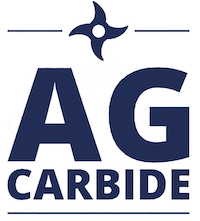Composition, structure and properties of cemented carbide
Composition: the main components of cemented carbide are WC, CO and tic, and the secondary components are tin, Ni, Mo, TAC, NBC, VC, Cr3C2, etc. Among them, WC (including TIC) accounts for more than 80% and co accounts for less than 20%. The proportion of other components is very small.
Structure: the normal structure of tungsten cobalt alloy is the two-phase structure of WC phase and co phase. The former is also called hard phase or α Phase, the latter is adhesive phase or β Phase. There are two normal structures of tungsten titanium cobalt alloys, one is (Ti, w) c+co two-phase structure, and the other is (Ti, w) + wc+co three-phase structure.
Performance: the main performance indicators of cemented carbide include density, bending strength, hardness, coercive force, cobalt magnetism, etc. Density is the most basic index of cemented carbide quality, and it is the basis of other properties. Hardness and bending strength are the two main mechanical properties of cemented carbide, which directly affect the application effect of the alloy. These three properties basically determine the comprehensive quality of cemented carbide, which is not only the evaluation index of products leaving the factory, but also the index that users pay most attention to, and an important basis for the rational selection of cemented carbide.
Functions of several commonly used substances in tool materials:
WC – wear resistant phase, the main component of tool material;
Co – ductile phase, with the increase of CO content, the strength and toughness of the alloy increase and the hardness decreases;
TiC – hard phase, with the increase of TiC content, the anti crater wear ability of the alloy increases, but the strength and toughness of the alloy decreases, and the brittleness of the alloy increases;
TAC, NBC – hard phase, which can significantly improve the high temperature performance and wear resistance of the alloy. The alloy with TAC and NBC has good versatility;
CRC, VC inhibitor, inhibiting WC grain growth
According to different compositions, cemented carbides can be divided into five categories.
- Tungsten carbide based cemented carbide: including WC Co, WC tic Co, WC TAC Co, WC tic tac (NBC) -co, etc. These alloys are mainly composed of WC.
- Titanium carbide based or titanium carbonitride based cemented carbide: a kind of cemented carbide usually composed of tic or Ti (C, n) as the basic component and Ni Mo as the binder. Such as tic Mo Ni, tic WC TAC (NBC) -mo Ni, Ti (C, n) -mo Co Ni, etc.
- Coating cemented carbide: deposit a layer of tic, tin, TiB2, ZrN, CrN, AI2O3, TiCN, B4C, SiC, BN, TiAIN, diamond and other substances on the alloy surface, so as to double the service performance of the tool.
- Steel bonded cemented carbide: a kind of cemented carbide whose main component is steel and whose hard phase is tic or WC. Its remarkable feature is that it can be heat treated and machined. It is a kind of intermediate alloy between tool steel and cemented carbide.
- Other cemented carbide: such as Cr3C2 based cemented carbide, which is composed of Cr3C2 as the main component and Ni or Ni-W as the binder. It is usually used as wear-resistant and corrosion-resistant parts.
- In addition, there are two important tool materials. One is ceramic materials, including alumina (white pottery), silicon nitride and Theron ceramics (si3n4/al2o3). The other is superhard materials, polycrystalline diamond (PCD) and polycrystalline cubic boron nitride PCBN.
